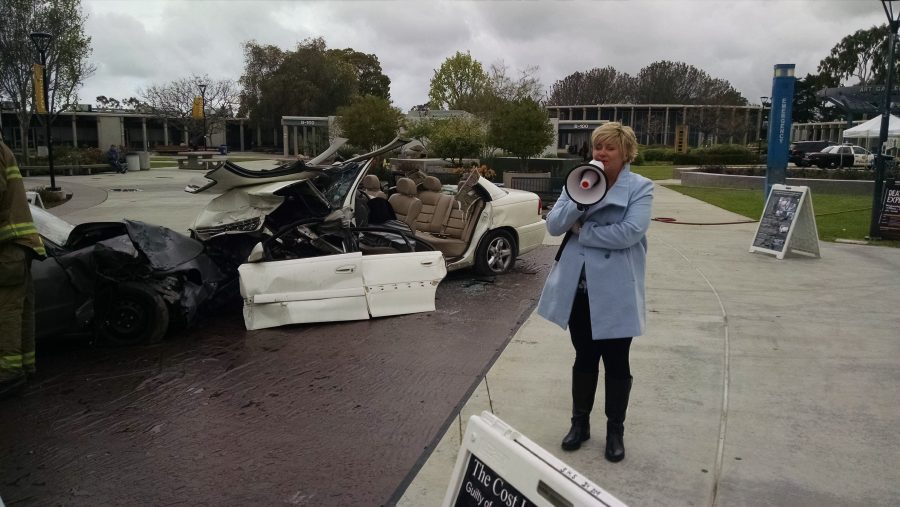Under a dark, rainy sky, students at Mesa College were given a look at something even darker–the potential risks and consequences of driving under the influence.
The Death Experience, put on by Mesa College’s Student Health Services, along with the San Diego Community College Police and San Diego Fire Department, returned to campus for a fifth consecutive year to raise awareness of distracted driving as well as driving under the influence, along with demonstrating the proper techniques for removing crash victims from a vehicle. Also present was Carolyn Bright, the San Diego County prosecutor for DUI cases.
Students who visited the event were given a demonstration of a police sobriety test, and were given “beer goggles” and told to try walking in a straight line. The goggles simulated three different levels of intoxication: light, which was rather fuzzy, and sort-of impaired–simulating a blood alcohol content of 0.1-0.2; medium, which showed bluish vision, and even more impaired behavior, to simulate a BAC of 0.3-0.4, and last, but not least, flat out drunk–green, impossible to coordinate moving arms and legs, in order to simulate a BAC of 0.5 or more. To the surprise of nobody, students given goggles with each increasing intoxication stage had a harder time walking straight.
Bright explained that even “just a couple of drinks” can give someone a 0.3 BAC–just enough to impair vision and judgement. She went on to say that even with services like Uber and Lyft, there have been more drunk driving accidents in the last several years, particularly among people ages 18-25. In addition, most restaurants and bars will make sure people don’t go driving after drinking. She said, “We will go out and prove you were drinking while driving, despite every attempt to stop you. We will go look on your phone, at closed-circuit footage, to prove it, and if we do, you can be charged with murder, and you can be sentenced from 15 years to life.” In addition, as strange as it might seem, the state has no “drunk driving” definition. Rather, to put the law in basic terms, drunkenness is being extremely impaired.
Next, the Fire Department arrived, and they demonstrated their techniques and tools for removing accident victims. They shattered the windows, cut seat belts, punctured tires, cut out the pillars that supported the roof, and then used the “jaws of life” to further dismember the car. It took them about half an hour to turn an already-totaled vehicle into scrap metal; in a real accident, it would take them a lot less time, owing to having men on both sides of the car. One firefighter said that they try to “pull the car away from the people, rather than the people out of the car.”
During this, Bright told observers that oftentimes she gets calls at 2 a.m. to respond to these crash scenes, which are more chaotic in real life, and also include paramedics and police. Signs placed around the junked cars placed up stories of people involved in these kinds of accidents, along with numerous facts and figures about the dangers of distracted driving. One sign showed all the fines and fees involved in a DUI, along with having a police record to place the cherry on top.
All this serves to drive home a simple, sobering lesson about drunk driving:
Don’t even think about it.


